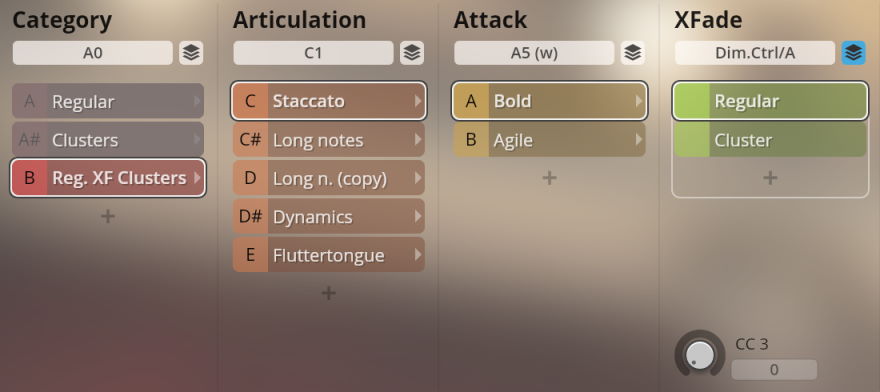
The instruments were recorded at Stage A, the main hall of Vienna’s revitalized Vienna Synchron Stage. The recordings were executed using an expansive, phase-controlled multi-microphone set-up, capturing solo and ensemble woodwinds played in a scoring stage with exceptional acoustics, now ready to be used in your studio. This document will provide you with the information you need to use the Library with our Vienna Synchron Player.

All instruments were recorded using 11 microphones, subdivided into 7 sections. The Standard Library includes 4 of these sections (as well as a RAM-friendly Room Mix section composed of merged samples from the individual positions), allowing you to integrate instruments recorded with a stereo Decca tree into your projects using the Vienna Instruments and Vienna Instruments Pro players or our mixing hosts Vienna Ensemble and Vienna Ensemble Pro. Adding the Extended Library and thus getting the Full Library expands your possibilities to 5.1 surround and Auro 3D 9.1.


Standard Library
- Room Mix – Stereo
- Close Mic – Mono
- Mid Layer Mic – Stereo (L/R)
- Main/Room Mic – Decca Tree Stereo (L/R)
- Main/Room Mic – Decca Tree Mono (Center)
Extended Library
- Main Surround – Stereo (L/R)
- High Stereo (3D) – Stereo (L/R)
- High Surround (3D) – Stereo (L/R)
The instrument Presets also include different mixer presets. By default the classic room mixes are loaded which include the Standard Library microphone positions "Room-Mix", "Close" and "Mid". These are balanced in the stereo field to represent the respective instrument’s position in the Synchron Stage set-up.
Auro 3D is an immersive audio technology that allows for three-dimensional sound perception. The Belgian company Auro Technologies developed this technology based on a special speaker configuration, adding four additional speakers to a 5.1 surround configuration. These speakers (so-called "Heights") are situated above the front and surround speakers and generate acoustic reflections that are perceived naturally due to the fact that sounds originate from around as well as from above the listener. Thanks to the comprehensive selection of discrete audio channels with the Full Library, you may mix your instruments in Auro 3D as well as in Dolby Atmos.
The library offers three basic Preset types for every instrument in their respective folders, marked "Velocity", "VelXF", and "VelXF sus". In the regular "Velocity" presets, note volume is controlled by keystroke velocity just like a piano. In "VelXF" Presets, all articulations have velocity crossfading activated so that you can control dynamics with MIDI controller CC1, the modwheel. In "VelXF sus" Presets, however, velocity crossfading is only activated for long notes, while the dynamics of short notes are controlled by keystroke velocity, thus facilitating phrasing. Velocity crossfading can be enabled or disabled by clicking its on/off symbol in the Synchron Player's Perform tab.
The Presets of each instrument are subdivided into several Articulation categories (depending on the instrument) plus a "Custom" slot ready for your own creations. With the exception of the FX presets, these categories are:
- Short Notes
- Long Notes
- Legato
- Dynamics
- Flutter tonguing and trills
- Fast repetitions
Within these Articulation categories, you can select a Type, e.g., regular or long portato, and for some of the types there are additional options available, such as marcato or vibrato type control.
For each instrument, there are a number of Mixer Presets for stereo and surround microphone configurations that depict different recording situations: Close, Classic, Wide, Distant, Ambience, Lush, Lush long, Sparkling, and Catchy (the latter four only for stereo set-ups). Apart from that, you will also find Processed Standard Mixer Presets, which give you an idea of the possibilities and may present a good starting point for your own creations.

The instrument Presets comprise all recorded Patches in articulation groups, which again contain types of the respective articulation, with further options if available. The general structure was adheres to that of our other Synchron Collections, making it easy to switch or combine instruments without major adaptations.
Articulations are disabled by default. Enabling an articulation means that all the types contained will be activated, too, so if you happen to be short of RAM it is advisable only to activate what you really need (you can always add more types later).
By default the keyswitches for articulations are mapped starting from C1 (for Middle C = C4) for higher instruments, and from C5 for the contrabassoon. For the available types, the keyswitches start from C2 for high instruments, and from C6 for low ones.
Additional options within articulations or types are offered by the Dimension Controllers. The controller function is indicated by the respective caption, as of course it may take on different tasks as needed.
Apart from the regular articulations, every instrument also features one called Custom that does not contain any samples. It provides 6 slots ready for you to configure presets of your own.
The flutes (Piccolo flute, Flute 1, Alto flute), Oboe 1, English horn, and bassoons (Bassoon 1, Contrabassoon) in this collection have mostly the same articulations and therefore very similar layouts. The clarinets, which do not offer vibrato variants, are listed separately.
- Articulation switches: C1–F1 / contrabassoon C5–F5
- Type switches: starting at C2 / bassoons C6
Short and long staccato bold and agile, portato bold and agile, and long portato with and without vibrato. Use Dim.Ctrl/C (CC30) to crossfade between long portato without and with vibrato.
- Bold/agile switch: A0/B0; contrabassoon: A4/B4
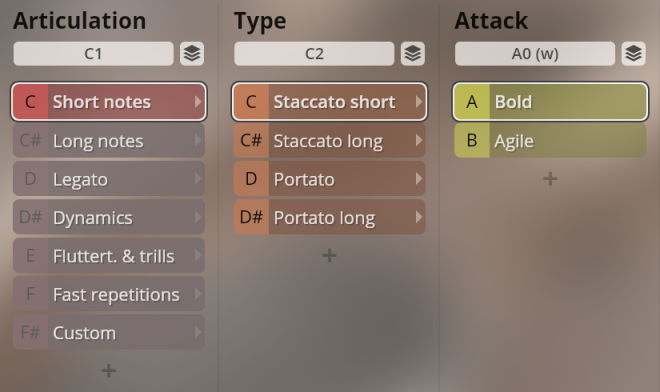
Use Dim.Ctrl/C (CC20) to crossfade between long portato without and with vibrato.
- Vibrato options: A2–B2 / A6–B6
- Vibrato XF: Dim.Ctrl/C (CC20)
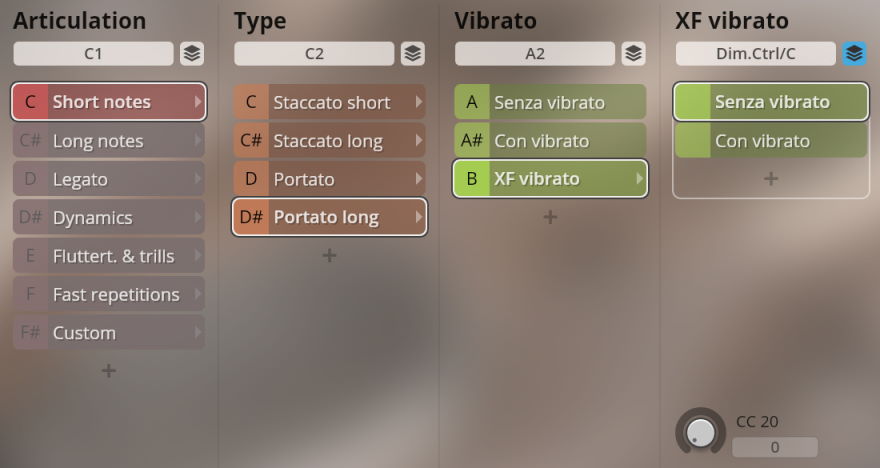
With the vibrato crossfading option, use Dim.Ctrl/C (CC20) to control the vibrato amount.
- Vibrato options: A2–B2 / A6–B6
- Vibrato XF: Dim.Ctrl/C (CC20)
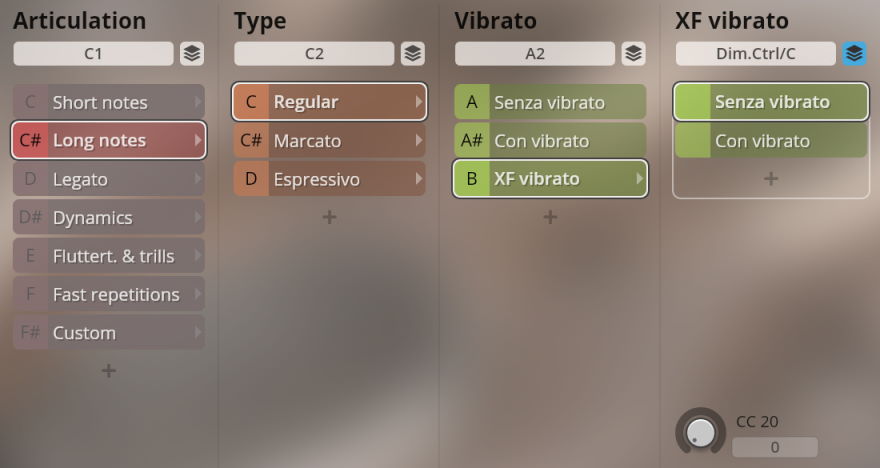
With the vibrato crossfading option, use Dim.Ctrl/C (CC20) to control the vibrato amount.
- Vibrato options: A2–B2 / A6–B6
- Vibrato XF: Dim.Ctrl/C (CC20)
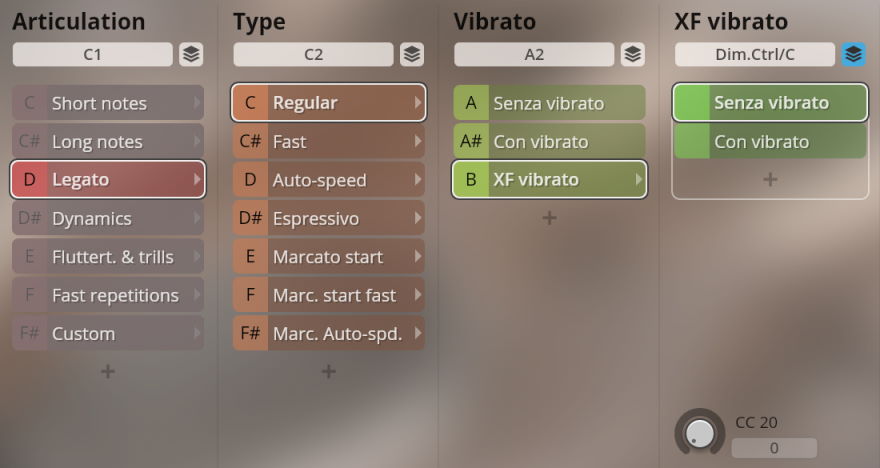
The Auto-speed option implements a controller on Dim.Ctrl/D to switch between normal and fast legato depending on playing speed.
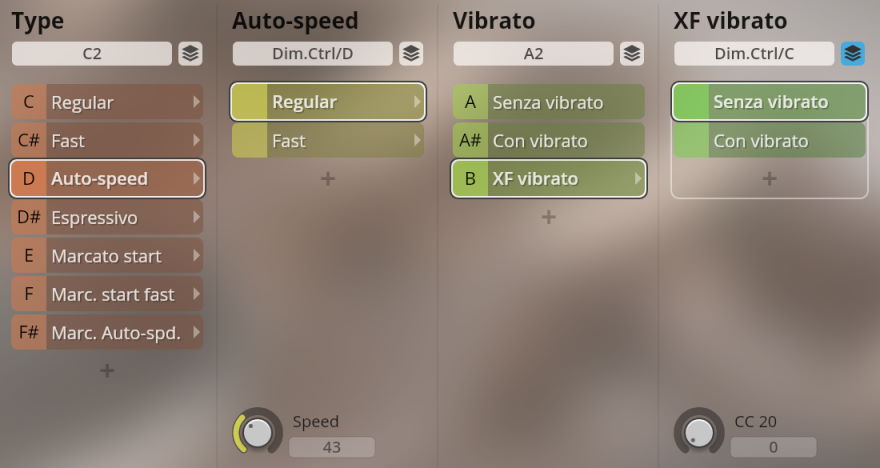
The piccolo flute does not offer sforzatissimo, but for reasons of continuity contains a copy of the sforzato patch in that slot.
- Type switches: only on white notes
- Vibrato options: A2–B2 / A6–B6
- Vibrato XF: Dim.Ctrl/C (CC20)
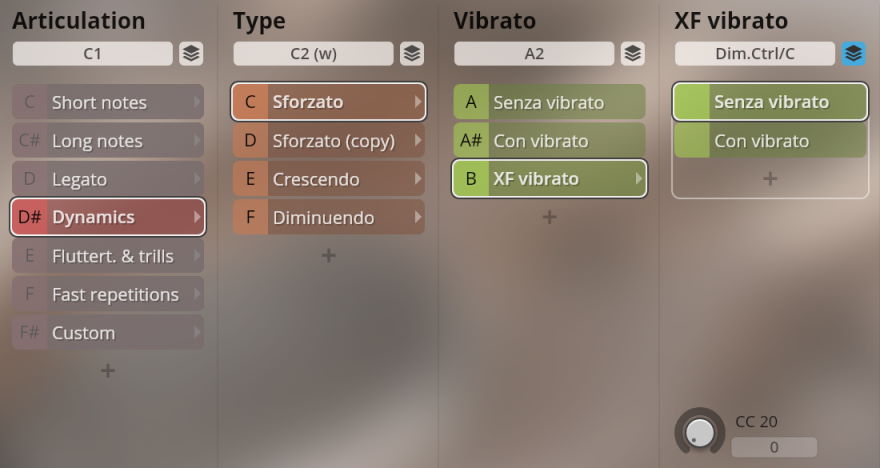
- Duration switches: F#2–G#2 / F#6–G#6
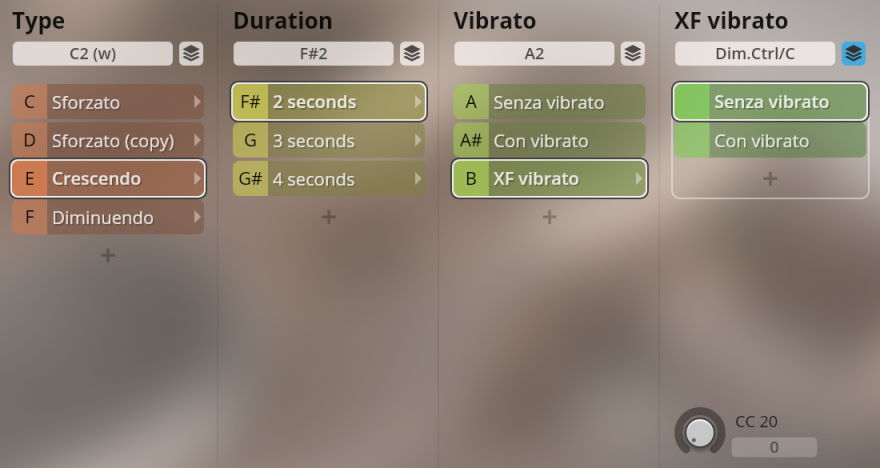
Flutter tonguing, normal and marcato; half and whole tone trills, normal and with legato transitions.
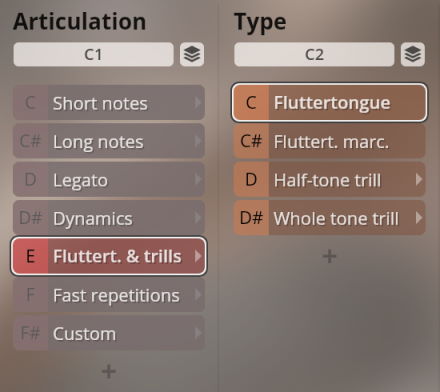
- Normal / legato transition: A0/B0; contrabassoon: A4/B4
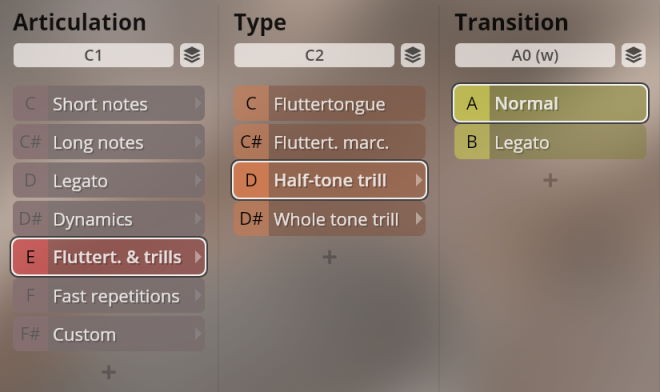
Fast repetitions from 120 to 160 BPM with ringing and cut release.
- Ringing/cut release: A0/B0; contrabassoon: A4/B4
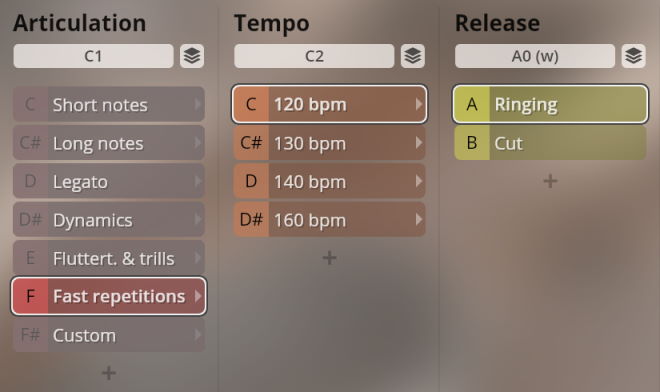
- Articulation switches: C1–F1
- Type switches: clarinet starting at C2, bass clarinet at C6
Staccato short and long bold and agile, regular portato bold and agile, and long portato.
- Bold/agile switch: A0/B0

Sustained notes, regular, marcato, and espressivo.
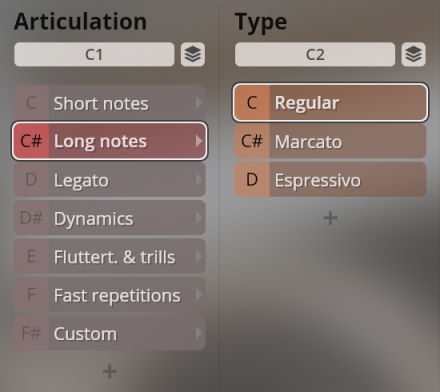
Performance legato, regular and fast, espressivo, and with normal and fast marcato start, as well as auto-speed options.
The Auto-speed option implements a speed controller on Dim.Ctrl/D to switch automatically between normal and fast legato.
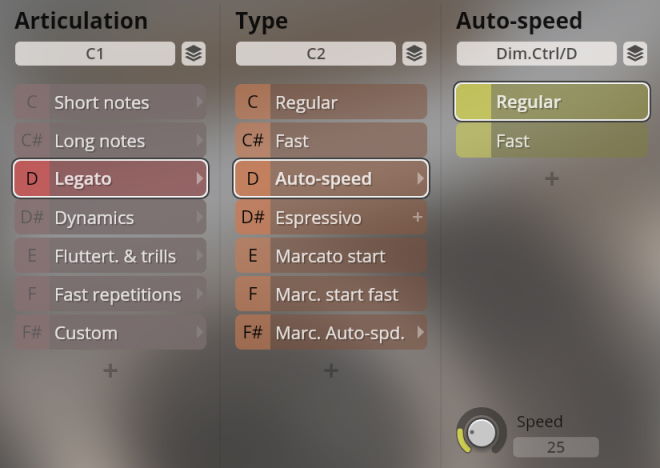
Sforzato, sforzatissimo; light and strong crescendo and diminuendo 2/3/4 sec.
- Duration switches: clarinet F#2–G#2; bass clarinet F#6–G#6
- Light/strong dynamics: clarinet A2/A#2, bass clarinet A6/A#6
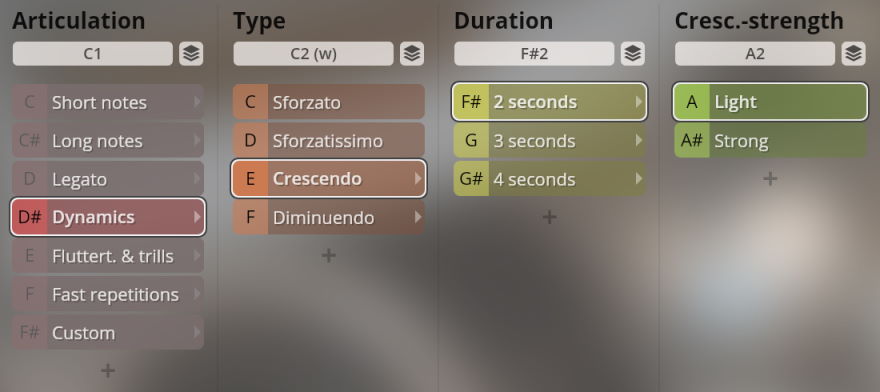
Flutter tonguing, normal and marcato; half and whole tone trills, normal and with legato transitions.
- Trills normal / legato transition: A0/B0
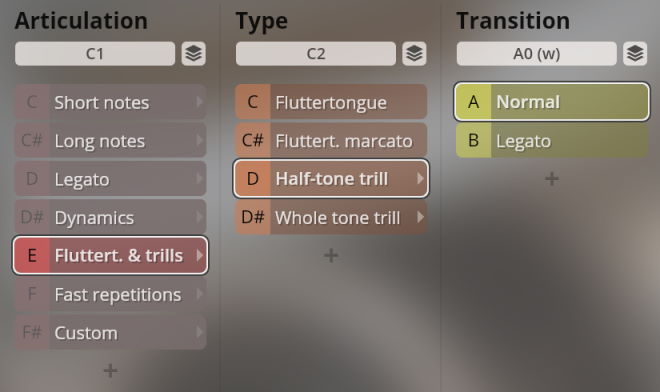
Fast repetitions from 120 to 160 BPM with ringing and cut release.
- Ringing/cut release: A0/B0

Each of these ensembles consists of three players.
- Articulation switches: starting at C1
- Type switches: flute, clarinet, and oboe ensembles starting at C2; bassoon ensemble starting at C6
Staccato bold and agile.
- Bold/agile switch: A0/B0

Sustained notes, regular, marcato, and espressivo.
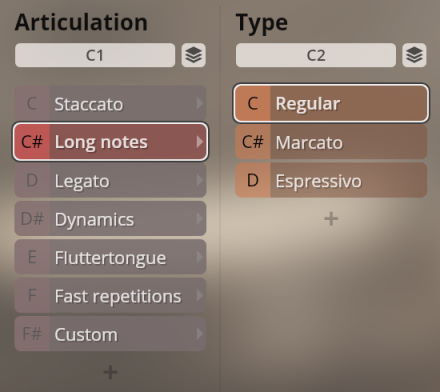
Performance legato, regular, with marcato start, and espressivo.
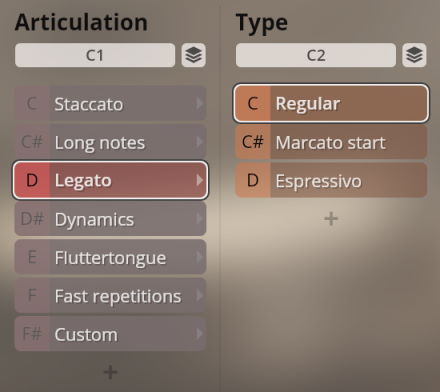
Sforzato normal and with subsequent swell; crescendo 1.5/3/4 sec.
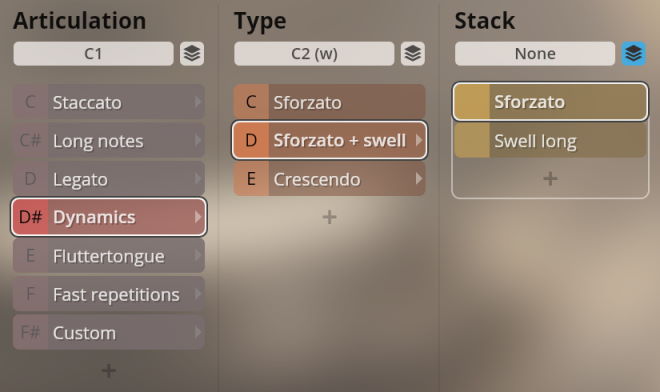
- Duration switches: flutes, clarinets, oboes F#2–G#2; bassoons F#6–G#6

All ensembles except bassoons: Flutter tonguing normal and marcato.
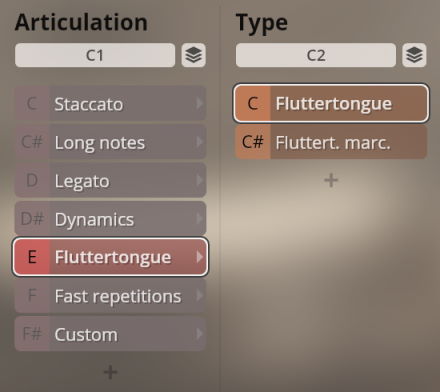
All ensembles except bassoons: Fast repetitions at 120/140/160 BPM with ringing and cut release.
- Ringing/cut release: A0/B0
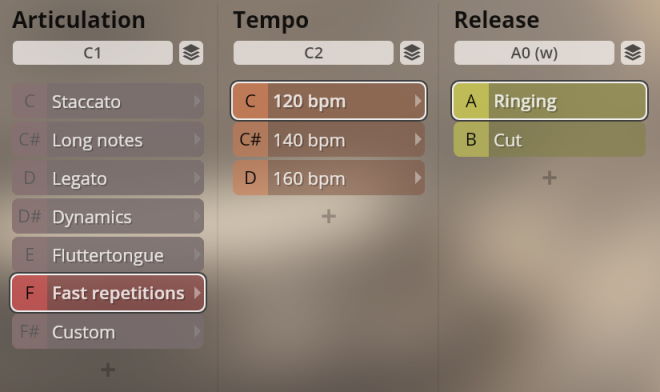
Woodwinds tutti in variants with and without the piccolo flute.
- Senza / con piccolo: A0/B0
- Articulation switches: C1–F1
- Type switches: starting at C7
Staccato bold and agile.
- Bold/agile switch: A6/B6
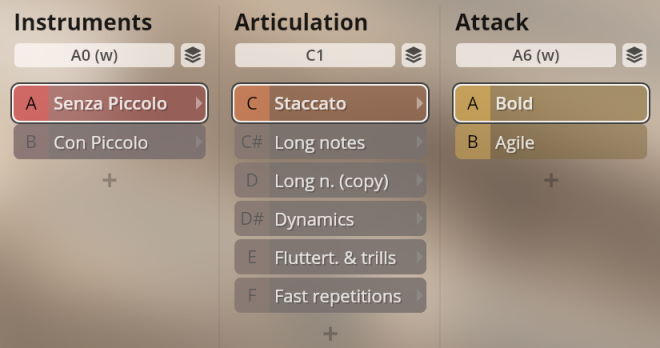
Sustained notes, regular, marcato, and espressivo. The marcato amount is controlled by keystroke velocity (Dim.Ctrl/A).

Sforzato and sforzatissimo; crescendo 2/3/4 sec.
- Crescendo duration: F#7–G#7
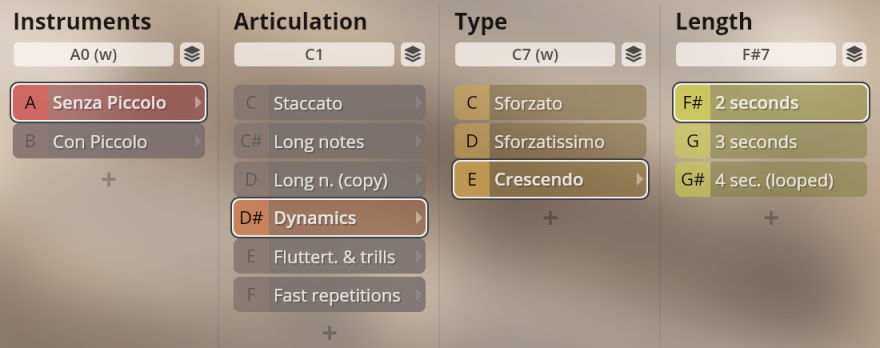
Flutter tonguing normal and marcato; half and whole tone trills. The marcato amount is controlled by keystroke velocity (Dim.Ctrl/A).

Fast repetitions at 120/140/160 BPM with ringing and cut release.
- Ringing/cut release: A0/B0

The high woodwinds with long notes, octave runs in keys and scales, and arpeggios.
- Articulation switches: C1–D#1
- Type switches: starting at C7
Not other options.

Plain runs play an octave from the starting note, and are mapped to two areas on the keyboard – the lower one for upward runs, the higher one for downward runs. Plain runs are also equipped with ringing and cut release. For perform octave runs, each note of the run has to be played in succession, so that these allow you to vary speed and volume.
- Key switches: C2–B2
- Plain / Perform: C3/D3
- Ringing/cut release: F3/G3

Scales: Ionian (major), Dorian, Phrygian, Lydian, Mixolydian, Aeolian (minor), Locrian, chromatic, and whole tone.
- Scale switches: C2–G#2
- Plain / Perform: C3/D3
- Ringing/cut release: F3/G3
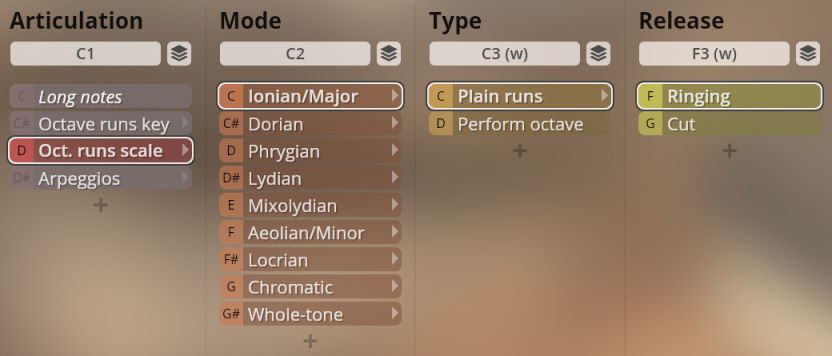
Chord types: major, minor, dominant 7, major 7, minor 7, minor with major 7, diminished, and augmented.
- Tempo switches: F1–G1
- Chord switches: C2–G2
- Direction up/down/cross: C3/D3/E3
- Release note lowest/highest/cut: F3/F#3/G3

Since there are no highest or lowest notes to finish on, the cross arpeggios offer only ringing and cut release.
- Ringing/cut release: F3/G3

The low woodwinds with staccato, long notes, dynamics, and flutter tonguing, played regular and in clusters, with crossfading options.
- Regular / Clusters / XF: A0/A#0/B0
- Articulation switches: C1–E1
- Type switches: starting at C6 (white keys only)
Staccato bold and agile.
- Bold/agile switch: A5/B5

Sustained notes, regular and espressivo. For continuity, the next slot contains a copy of this one, as there are no legato patches. This makes it easier to change instruments without having to make extra keyswitch adaptations in your score.
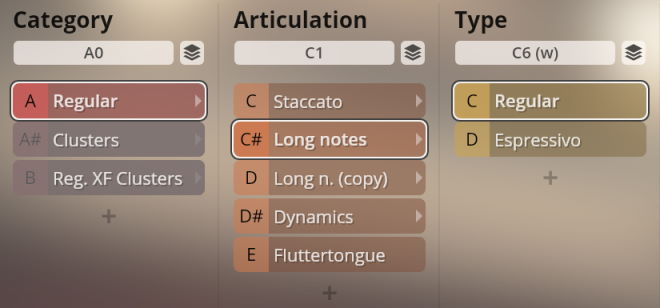
Sforzato and sforzatissimo; crescendo 2/3/4 sec.
- Crescendo duration: F#6–G#6
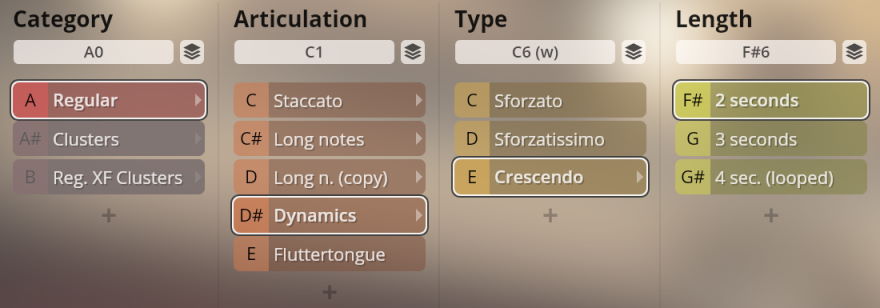
This category offers crossfading between regular and cluster articulations with the help of Dim.Ctrl/A (CC3).
- Regular/cluster XF: MIDI CC3
